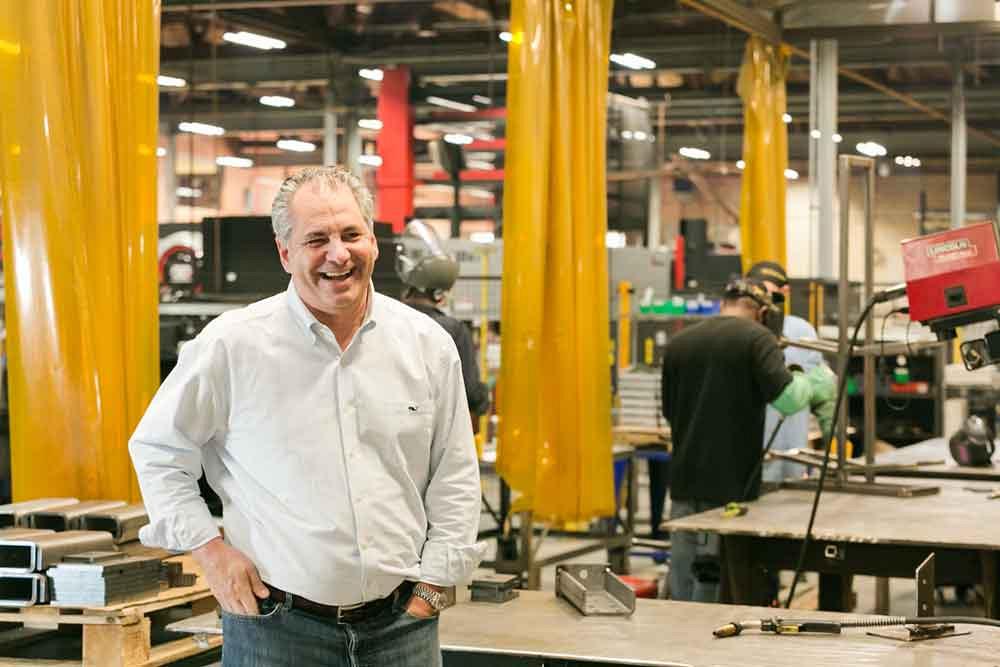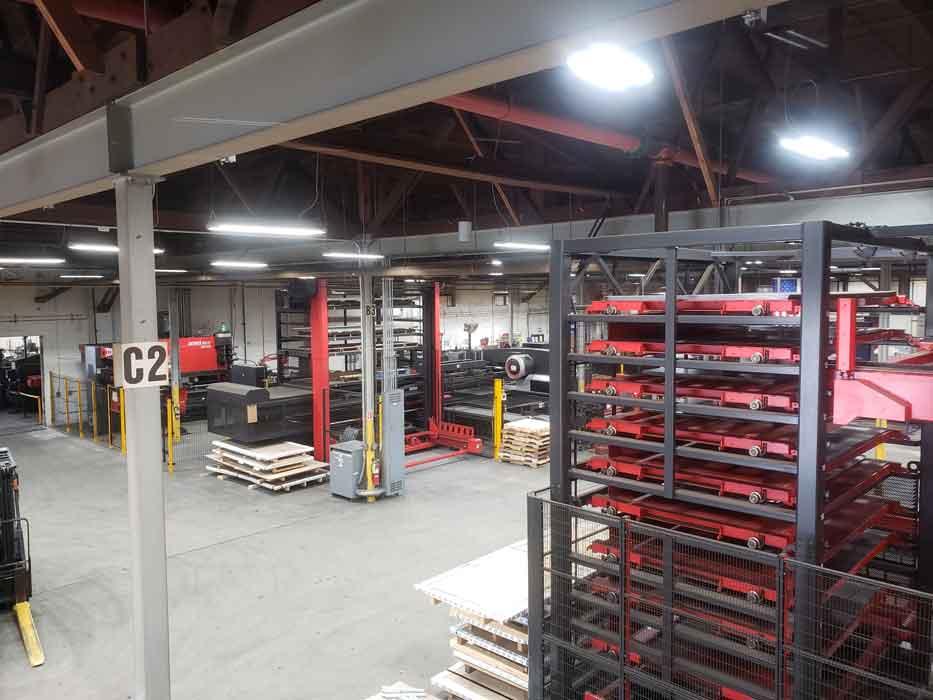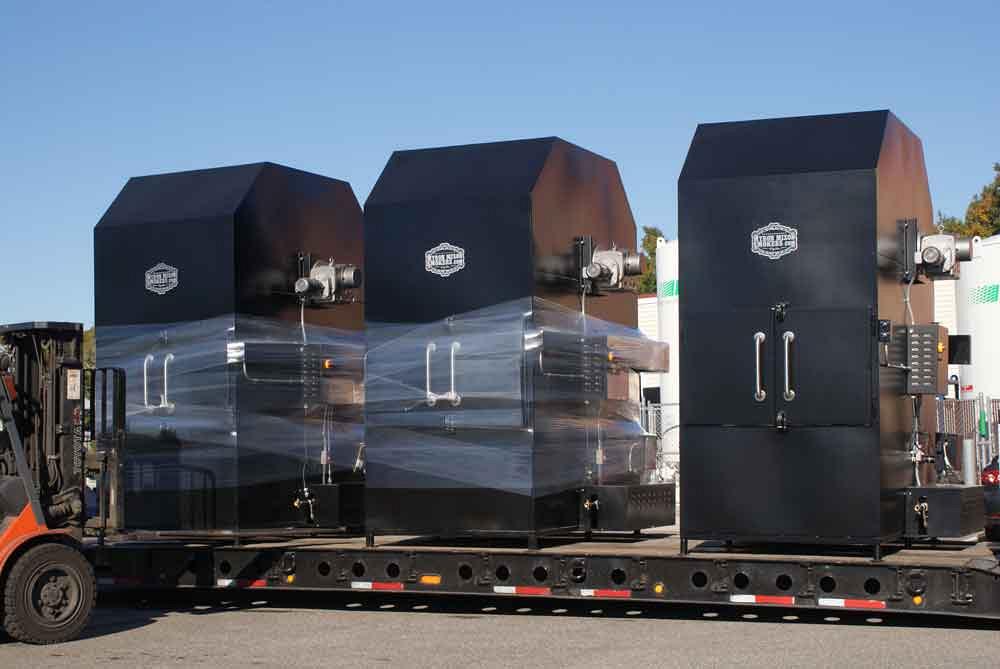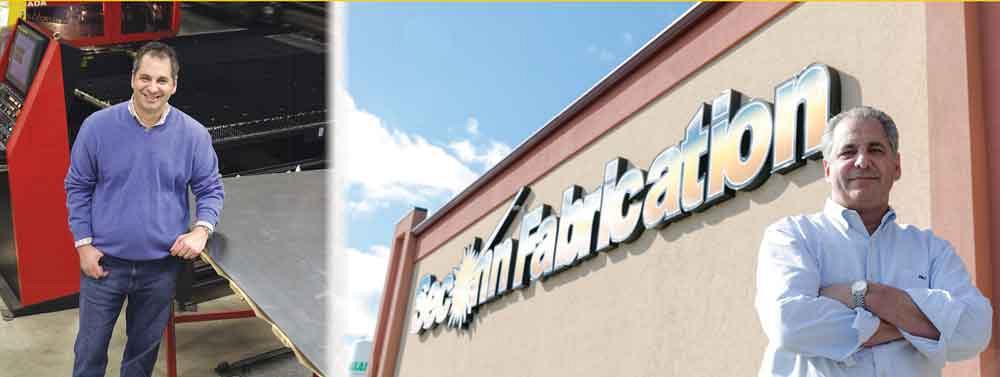Senior Editor
- FMA
- The Fabricator
- FABTECH
- Canadian Metalworking
Categories
- Additive Manufacturing
- Aluminum Welding
- Arc Welding
- Assembly and Joining
- Automation and Robotics
- Bending and Forming
- Consumables
- Cutting and Weld Prep
- Electric Vehicles
- En Español
- Finishing
- Hydroforming
- Laser Cutting
- Laser Welding
- Machining
- Manufacturing Software
- Materials Handling
- Metals/Materials
- Oxyfuel Cutting
- Plasma Cutting
- Power Tools
- Punching and Other Holemaking
- Roll Forming
- Safety
- Sawing
- Shearing
- Shop Management
- Testing and Measuring
- Tube and Pipe Fabrication
- Tube and Pipe Production
- Waterjet Cutting
Industry Directory
Webcasts
Podcasts
FAB 40
Advertise
Subscribe
Account Login
Search
Connecticut metal fabricator returns to its roots
Revisiting Industry Award winners: Seconn Fabrication renews its focus on contract fabrication
- By Tim Heston
- January 6, 2020
- Article
- Shop Management

Boisterous and quick to laugh, Rob Marelli has for years focused on growth and working in the trenches to make it happen. Now 52 years old, he’s changing roles.
Talk to Rob Marelli for five minutes and you feel like you’ve known him forever. He’s self-effacing, boisterous, quick to laugh, honest, and open. He’s not one to sugarcoat either. What you see is what you get. An entrepreneur in a business with technology as its backbone, Marelli thrives on human connection.
His business, Seconn Fabrication in Waterford, Conn., was The FABRICATOR’s first Industry Award winner. Back then, in 2008, Seconn was a $10 million operation that sprang from nothing just five years before. Marelli and his business have gone on quite the journey since then, launching, acquiring, and growing several ancillary businesses that by 2016 were bringing in $25 million annually. After a decade on the entrepreneurial hunt, both Marelli and his business are in many ways coming back home, returning to their roots. The organization’s entrepreneurial spirit hasn’t faded, it’s just more focused.
To celebrate The FABRICATOR’s 50th year, we’re revisiting our past Industry Award winners. We’ll cover how far those fabricators have come, what company leaders learned, and how they’ve changed. Most important, we’ll cover how people shape this business. Yes, metal fabrication has a technological backbone, but its head is the integrity of its best leaders.
About People
Marelli abhors bureaucracy and the politics that go with it. Ever the gunslinger, he’s at home in the thick of it. As the late Dick Kallage, industry consultant and former columnist for this magazine, used to say, “Truth isn’t revealed in meetings; it’s revealed on the shop floor.” Marelli couldn’t agree more.
Before launching Seconn in 2003, Marelli disliked the imaginary walls he saw at some companies—between the front office and the shop floor, between departments, even between individuals in the same department. Walls kill human connections, and without them, what really is the point of it all?
This doesn’t mean Marelli shies away from automation. Walk the shop and you’ll see evidence of the millions of dollars he poured back into the business. Automated material handling towers are everywhere. All lasers—the CO2 laser, the fiber laser, and the combo punch/fiber machine—have some sort of automated loading/unloading.
A robotic press brake designed for a variety of lot sizes works away in the corner. In the adjacent room is a custom robotic cell that automates both welding and hardware insertion. Near the back of the plant is another custom piece of automation for autogenous gas tungsten arc welding.
Marelli revels in the technology like anyone else in this business, but during the shop tour he didn’t spout throughput numbers or other productivity metrics. Instead, he talked about employee wages.
“We’ve developed a tremendous amount of capacity by being more efficient and productive,” he said, adding that, besides machinery, the company instituted regular kaizen events and focused on building work volume at its core customer base. “For our first 10 years in business, our wage-to-sales ratio was around 20%. It’s now less than 10%. Our people are making more money, and everyone is hitting their targets for bonuses.”
As the company grew post-recession, any work that disrupted flow was simply separated from it. Within a few years the company put its especially low-volume work in a separate facility, and certain assembly work was being done in still another facility. “By 2013 it seemed we were taking our disruptions and setting them in little satellite locations,” Marelli said. “But over a few years we spent about $5 million on new equipment. It completely changed the dynamics of our main facility.”
Now the shop has become so productive that it has been able to absorb work from those satellite locations. Everything happens under one roof, which is good for productivity and communication. Marelli has fewer walls to worry about.
What’s Next?
Marelli always has been drawn not to the now, but to the what’s next—and no wonder. The recession hit Seconn significantly in 2009. Sales dropped more than 30%. It wasn’t devastating, but it wasn’t a cakewalk either. Wallowing in the now wouldn’t do. So, what’s next?
“I knew what my threshold for pain was,” Marelli said. “We did a lot of things to survive, whether it was consolidation of debt, lean events, cross training, pay cuts. We did what we had to do. But for the first time, I knew I wasn’t afraid to make the tough decisions. We got through 2009 with a little bit more profit than we did in 2008, and we did it on 30% less sales.”
From this came a quest for revenue diversification and becoming a one-stop shop. The more value Seconn could provide its customers, the more stable and diverse its revenue stream could become. The company added more services, including machining and silk screening, and increased its assembly capabilities.
So, what’s next?By 2011 robust orders emerged again from core customers, and in the summer of that year Marelli received news from a four-person automation integration team that worked at an independent welding distributor nearby. The distributor was being purchased by a large corporation, and the team wanted no part of it. They focused on automation for high-product-mix work, a niche that seemed to fit Seconn perfectly.
“The team came over and became gainfully employed by Seconn Fabrication,” Marelli recalled. “They began streamlining our company with some custom cells, and they began setting up to become a robotic integrator. I was more of the financial piece behind it, recognizing that there was going to be a labor shortage, and automation was the way to be successful.” With that, Seconn established its automation division, which tackled both in-house projects (which helped Seconn become more competitive) and outside integration work.
So, what’s next?How about Myron Mixon? Yes, that Myron Mixon from cable TV’s “BBQ Pitmasters.” In 2012 Marelli hosted a large picnic for family and friends. A smoker cooker enthusiast, Marelli watched Mixon for years, and he also knew the community had just weathered Hurricane Sandy. Everyone had endured, and it was time for celebration. A surprise to no one, Marelli decided to go big.
“I reached out to Myron Mixon to come in and cook for us. And we just hit it off. We hung out the whole weekend.”
The more the two talked, the more they could relate. Mixon lives in a small south Georgia town, Marelli works and lives in a small New England town. Like Marelli, Mixon has various business interests. They even shared similar family situations. They related fully, both personally and professionally, so much so that at some level their lives seemed to be running in parallel.
One day Mixon asked Marelli if he could design and build a prototype for smokers. “I showed up at the Jack Daniel’s Invitational down in Lynchburg, Tenn., with some prototypes,” Marelli said, “and the guys on Mixon’s cook team loved them. We went out to dinner that night, and he said, ‘I think we should build pits and start a business. Why? Because I know, due to our friendship, you won’t sacrifice quality in producing these products.’ I told him, ‘I don’t know a damn thing about barbequing.’ And he said, ‘I don’t know a damn thing about running a business.’”

With extensive investment in automation, Seconn has been able to move more operations under one roof.
With that, the two shook hands, and Myron Mixon Smokers was born. “I bought the building across the street, added a 4,500-square-foot warehouse, and remodeled the whole building,” Marelli said. “I put a sales team over there, advertising and marketing people, and added a test kitchen. And we were shipping everything from here. I just loved it. The people we sold these smokers to are just good people. And it was good for our business. It increased cash flow and diversified our revenue, because we had a proprietary product.”
So, what’s next? How about an indoor softball and baseball facility? Wait …. what?When Seconn increased its automation investment, it found it could produce more in less space, which meant it could bring an assembly operation in nearby Niantic, Conn., back into the main plant. So what does one do with an empty, 10,000-sq ft assembly plant in downtown Niantic? Selling it was an option, but of course, Marelli thought differently.
The area is full of baseball and softball enthusiasts, including one of Marelli’s three daughters. Thing was, he knew how he, his wife, and other softball parents spent their weekends, ferrying their child to a geographically isolated practice facility just far enough away that returning home wouldn’t make sense.
Seconn’s recently vacated assembly plant was downtown, close to eateries, coffee shops, a movie theater, and Waterford’s waterfront walk. What better place to put a practice facility? In 2016 Marelli paid to renovate the entire plant and hired his daughter’s softball coach to run it. “People now could drop their kid off for practice, go to coffee shops, walk along the boardwalk,” Marelli said. “The place just blossomed immediately.”
So, what’s next?
Time for a Reset
In 2006 Seconn was just starting to take off. The shop had moved out of a leased facility into its current location and Marelli had just finished a $1.5 million plant remodel, when a veteran job shop owner from down the street paid a visit. “He told me, ‘Keep it small and keep it all.’ Well, I was 40 years old, full of piss and vinegar. I really didn’t understand. I thought, ‘We’re rocking now.’”
Ironically, five years later Seconn purchased that same industry veteran’s job shop and converted it into a satellite location for low-volume work (which eventually was brought into the main plant). Seconn continued to rock.
Telling the story, though, Marelli paused, then pointed to the family photos around his office. “When I started Seconn, I had a 1-year-old daughter, Ava, at home and another daughter, Lily, on the way. And I have a third daughter now, Olivia. I’ve missed a lot over the years. I missed the horseback riding, softball, soccer, music, and dance.”
In 2016 he thought again about that meeting, about staying small and keeping it all, and had an epiphany. What was next? For Marelli, more time with friends and family; for Seconn Fabrication, a major refocus.
After the 2016 presidential election an investor in Hartford gave Marelli a call and asked if he would be willing to sell Seconn’s automation division. The timing couldn’t have been better. The two reached a deal, and the formal separation occurred in 2017. “I got to take some chips off the table early, while I could still enjoy them, as well as a great tenant to occupy one of the commercial buildings.”
About seven months ago Marelli sold the baseball and softball business to his daughter’s coach, who continues to lease the building. Then in late 2019, he moved the sales, marketing, and warehousing of Myron Mixon Smokers down to Georgia, where Myron’s son David handles the sales and distribution. “David handles the sales reps, he handles the dealers, he handles everything,” Marelli said, adding that Seconn now just fabricates the smokers to order and ships them to Georgia. “We now focus on what we do best, [which is] manufacturing,” Marelli said.
So now what’s next for Marelli? With the business more operationally focused, he’s looking to build his management team and to spend more time with his family. He’s not keeping the business small, not by a long shot. Seconn will continue its fabrication focus. In 2020 the company is planning for 5S events and other continuous improvement initiatives, and its investments in technology will continue unabated. But Marelli’s role, though still important, will be much smaller. Marrelli paused, smiled, and added, “And less stressful.” With the rest of the organization focused on operational initiatives, he’ll focus on broader strategy, less on the day to day.
“Do I continue on as I have, and hope the kids will come back to me with their grandkids someday and understand everything? Or do I find extra bandwidth, people who’ve done this before and who can offer support? With that, I can still have the best of both worlds. I can come [to work] in the morning and have some fun. Then when I’m done with work, I go home, sit on the porch, watch a rainy day, and wait for the kids to come home.”
In this sense, Marelli’s moved on from what’s next. Asking it has given him success and financial security. He now aims to focus on what is—those human connections and contentment that, for Marelli and the rest of us, make life worth living.
About the Author

Tim Heston
2135 Point Blvd
Elgin, IL 60123
815-381-1314
Tim Heston, The Fabricator's senior editor, has covered the metal fabrication industry since 1998, starting his career at the American Welding Society's Welding Journal. Since then he has covered the full range of metal fabrication processes, from stamping, bending, and cutting to grinding and polishing. He joined The Fabricator's staff in October 2007.
subscribe now

The Fabricator is North America's leading magazine for the metal forming and fabricating industry. The magazine delivers the news, technical articles, and case histories that enable fabricators to do their jobs more efficiently. The Fabricator has served the industry since 1970.
start your free subscription- Stay connected from anywhere

Easily access valuable industry resources now with full access to the digital edition of The Fabricator.

Easily access valuable industry resources now with full access to the digital edition of The Welder.

Easily access valuable industry resources now with full access to the digital edition of The Tube and Pipe Journal.
- Podcasting
- Podcast:
- The Fabricator Podcast
- Published:
- 04/16/2024
- Running Time:
- 63:29
In this episode of The Fabricator Podcast, Caleb Chamberlain, co-founder and CEO of OSH Cut, discusses his company’s...
- Trending Articles
Tips for creating sheet metal tubes with perforations

Supporting the metal fabricating industry through FMA

JM Steel triples capacity for solar energy projects at Pennsylvania facility

Are two heads better than one in fiber laser cutting?

Fabricating favorite childhood memories

- Industry Events
16th Annual Safety Conference
- April 30 - May 1, 2024
- Elgin,
Pipe and Tube Conference
- May 21 - 22, 2024
- Omaha, NE
World-Class Roll Forming Workshop
- June 5 - 6, 2024
- Louisville, KY
Advanced Laser Application Workshop
- June 25 - 27, 2024
- Novi, MI





























